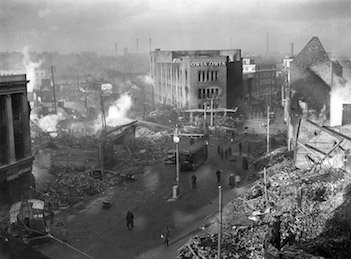London Blitz climaxed 75 years ago
As you’re pondering your Christmas presents, hazily watching TV in the fug of post-prandial bliss, or planning for New Year’s Eve … spare a thought for the city across the sea, London, exactly 75 years ago. For December 1940 saw its citizens enduring some of the most savage and damaging air attacks of the Second World War on the British capital. Night after freezing night people would flock to subterranean shelters, but even these were not protection enough from the searing rockets from the sky. The attacks culminated on the 29th, with scores of deaths and the destruction, among hundreds of buildings, of eight churches designed by Sir Christopher Wren.
However, due to the courage of firefighters, some were saved, including the famous St Paul’s cathedral. The image of it standing intact among the smoke and ruins became one of the most famous pictures of the war, and indeed of the 20th century.
The blitzkrieg – “lightning war” in German – was part of the Battle of Britain, which involved aerial dogfights between British and enemy craft. The Royal Air Force says the hardest fought day was August 18, when the Luftwaffe flew 850 sorties, involving 2,200 crew. According to history.com, the first attacks by the Royal Air Force on Berlin the previous August had so infuriated Hitler that he ordered the Luftwaffe to concentrate on bombing London.
The Blitz by the Luftwaffe (German air force) had started in September, and continued for 57 terrifying and ruinous nights. The Royal Air Force Museum notes that bombs fell every night but one between mid-September and mid-November. With the British will unbroken, and counter attacks on German targets, the Blitz continued, although spasmodically, until May 1941.

Thousands died, mostly as buildings collapsed on them or flying shrapnel cut flesh. The bombing was extended to other major British cities, including Birmingham, Manchester, Sheffield and Coventry. The latter was attacked viciously in mid-November, and lost its medieval cathedral, nearly 600 human lives and three-quarters of the city’s structures.
On December 29 1940, German pilots dropped countless incendiary bombs on the British capital, to create a massive firestorm. Individually,1,500 fires blazed that night, 52 of them classed as “serious”, 28 as “major”, and six as “conflagrations” – the largest of which covered half a square mile.
The comportment of the British, especially in London, became legendary. Their stoic acceptance of the suffering lives on in the bags and t-shirts, especially produced around the 70th anniversary in 2010, bearing the phrase “Keep Calm and Carry On”.
To be even-handed, it must be remembered that a number of German cities also suffered terrible destruction at the hands of Allied bombers. Dresden, in particular, is famous for the devastation and deaths wrought towards the end of the war, in bombing raids by British and US pilots. More than 20,000 people died.
The Blitz has been recreated in fiction and film, such as Hope and Glory, John Boorman’s 1987 film, but is mostly seen in documentaries such as the 1943 Fires Were Started, which began life as a training film but was so good it reached a wider audience.
Recently, Kate Atkinson’s novel Life After Life, which won the Costa Prize for Fiction in 2013, included lengthy and graphic accounts of the bombing, through the eyes of the citizens who took on the roles of air raid wardens.
The bombing of Belfast, where over 1,000 people died, is also recounted in Brian Moore’s novel The Emperor of Ice Cream. Moore himself had acted as an air raid warden in his home city, which was not blitzed until 1941, and was an obvious key target because of its industrial importance.
The death toll attributed to the Blitz is about 45,000, with the vast majority in London, and about the same number badly injured. However strategically it was regarded as a failure: the British did not surrender, and major industrial and military installations survived. Today we worry about muggers, we are terrified by the thought of ISIS/Da’esh – but 75 years ago Londoners had the certainty of death from the skies, all night, every night.
(The photo of St. Paul’s was taken by Herbert Mason for the Daily Mail, from the roof of the newspaper’s building –iconicphotos.wordpress.com)
Other Sources:
The Second World War, by Antony Beevor – Back Bay Books 2013
History.com
Military-history.org
RAF museum website
